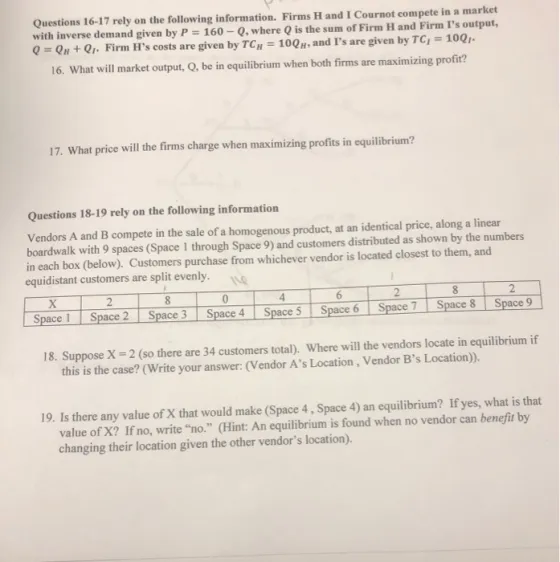Answered step by step
Verified Expert Solution
Question
1 Approved Answer
Questions 16-17 rely on the following information. Firms H and I Cournot compete in a market with inverse demand given by P= 160-Q, where

Questions 16-17 rely on the following information. Firms H and I Cournot compete in a market with inverse demand given by P= 160-Q, where Q is the sum of Firm H and Firm I's output, Q=QH+Q. Firm H's costs are given by TCH= 10QH. and I's are given by TC = 100,- 16. What will market output, Q, be in equilibrium when both firms are maximizing profit? 17. What price will the firms charge when maximizing profits in equilibrium? Questions 18-19 rely on the following information Vendors A and B compete in the sale of a homogenous product, at an identical price, along a linear boardwalk with 9 spaces (Space 1 through Space 9) and customers distributed as shown by the numbers in each box (below). Customers purchase from whichever vendor is located closest to them, and equidistant customers are split evenly. X Space 1 2 Space 2 8 Space 3 0 Space 4 6 4 Space 5 Space 6 1 2 Space 7 8 Space 8 2 Space 9 18. Suppose X=2 (so there are 34 customers total). Where will the vendors locate in equilibrium if this is the case? (Write your answer: (Vendor A's Location, Vendor B's Location)). 19. Is there any value of X that would make (Space 4, Space 4) an equilibrium? If yes, what is that value of X? If no, write "no." (Hint: An equilibrium is found when no vendor can benefit by changing their location given the other vendor's location).
Step by Step Solution
There are 3 Steps involved in it
Step: 1
ANSWER 16 In a Cournot competition firms set their output levels simultaneously taking into account the reaction of their competitors In this case Fir...
Get Instant Access to Expert-Tailored Solutions
See step-by-step solutions with expert insights and AI powered tools for academic success
Step: 2

Step: 3

Ace Your Homework with AI
Get the answers you need in no time with our AI-driven, step-by-step assistance
Get Started


